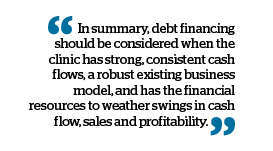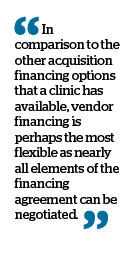Based on his own extensive experience, Reece Tomlinson explains the finance options available when purchasing another clinic
If you have considered growing your clinic via the acquisition of another clinic or business, you have likely experienced some of the challenges that can come with figuring out how to finance the acquisition itself. For many business owners, acquiring another company will be one of the single largest financial transactions of their professional careers. Financing an acquisition comes with a range of complexities that require diligent navigation and clear understanding of the options available.
This article helps to explain the options available for financing an acquisition based on my own experience completing acquisitions for companies I have led or on behalf of our clients.
The most common ways acquisitions are financed for private companies consist of:
1. Cash

The reason that purchasing a company entirely in cash is not advisable is due to the idea that it is generally more advisable for the company to keep cash on hand and use debt financing, which would be secured against the cash at a very low-interest rate, to fund the acquisition itself. By doing so, the clinic would benefit from some tax advantages, such as expensing the interest portion of the debt payment while keeping its cash within the company and maintaining liquidity. Only in very rare and unique situations is it beneficial to fund an acquisition entirely in cash.
2. Debt financing
Debt financing simply refers to a bank, or credit lending organisation, providing some percentage of the cash required to complete the acquisition. It is common for acquisitions to be paid for via debt financing, as debt is often cheaper than equity financing (to be explained next).
In many cases, debt funding can be obtained from traditional lenders (banks), non-traditional lenders (investment banks, specialty lenders, and government-funded business banks such as the British Business Bank), and private equity firms who specialise in financing acquisitions. Based on the lending institution, the financial strength of the acquirer, and the type of acquisition, lenders will often provide financing for 70–100% of the transaction value.
Given that debt financing will often have lower costs of repayment than other types of financing, such as equity financing, it is often a preferred choice for business owners as the primary method of paying for an acquisition. However, no different than obtaining a mortgage or a car loan, these funds do need to be paid back and as such they present inherent risks that the borrower must be aware of; with the most pressing risk being that paying a large monthly fixed payment can be detrimental to the clinic and deprive it of the capital it needs to operate.
In some situations, flexible financing can be provided by institutions that specialise in acquisition-based lending. In such a situation, the financing may have variable terms of repayment and can require the clinic to give up some equity if repayment is not made by certain milestones.
While debt is often the cheapest method of financing an acquisition, the clinic owner should be aware that they are often required to guarantee the loan via corporate or personal assets and often a personal guarantee will be required.
In summary, debt financing should be considered when the clinic has strong, consistent cash flows, a robust existing business model, and has the financial resources to weather swings in cash flow, sales and profitability. For clinics with a lot of cash on hand, it is often prudent to conserve cash and borrow money to pay for the acquisition rather than lowering cash on hand.
3. Equity financing
Using equity, which can simply be stated as an investment into the business in exchange for shares, is a common financing strategy for many companies seeking to complete an acquisition. Generally, the owner(s) of the clinic will provide shares in exchange for some or all of the capital required to complete an acquisition.

Depending on the value, growth trajectory, and profitability of the clinic; equity financing often becomes more expensive than debt financing when all factors are considered. For example, when reviewing the scenario listed above, if the clinic has regularly been making £200,000 per year in after-tax income; then the cost of using equity financing for the required £250,000 is 25% of the £200,000 after-tax income, which equates to £50,000 per year thereby representing a 20% annual interest rate. This cost becomes even more expensive when the company has other assets of value, grows or experiences a sale event.
Although equity financing is often more expensive, it does provide the clinic owner with a unique opportunity that often surrounds the lack of requirement to repay the investment, which means the clinic will not need to worry about making large debt payments.
In summary, equity financing is generally more expensive than debt financing; however, it is often more favourable for clinics that are growing fast, do not have a strong cash flow and may not have the capability of making regular debt payments. In particular, clinics that do not have large amounts of cash on hand may determine that equity financing is a less risky method of financing an acquisition.
4. Convertible debt
Convertible debt, which is defined as a form of debt that can be converted to another form of asset or security, generally refers to the ability of the party lending capital to convert the debt to shares at the discretion of the party whom holds the convertible option. Generally, the option to convert debt or equity often belongs to the party providing capital; however, in some situations, the borrower of that capital may have this option as well.
The benefit of convertible debt is that it can provide some flexibility that neither traditional debt or equity financing can offer. For example, if the clinic experiences success after completing an acquisition and has generated far better returns than anticipated; it is likely that the clinic will prefer to pay back the capital as debt versus providing equity in the business.
By virtue of this flexibility, which often benefits the party lending the capital, it does offer the clinic one primary advantage; it can lower the combined cost of borrowing debt and/or the cost of the equity. Because the lender has an increased ability to determine the most advantageous path for their own purposes based on the situation in front of them; they are often required to provider slightly better terms on both the debt and equity elements of the deal itself. As a result, convertible debt is often a desirable path forward for clinics that are confident in their ability to grow yet are uncertain of their ability to have enough cash on hand to cover any fixed debt payments.
5. Vendor financing
Vendor financing, which is also referred to as vendor take back financing, is when the vendor (seller) of the clinic is willing to provide a loan to the buyer rather than one or several lump sum(s) payments. This loan is then paid back, over a period of time, as negotiated between the buyer and the seller.

In comparison to the other acquisition financing options that a clinic has available, vendor financing is perhaps the most flexible as nearly all elements of the financing agreement can be negotiated. As a result, it is prudent to consider vendor financing on any acquisition; however, one should be careful not to suggest vendor financing until initial discussions are underway as many sellers are not initially open to the idea of selling their business in this manner and may back away from any further discussions.
Paying for an acquisition
In conjunction with understanding how an acquisition can be financed, it is necessary to understand how an acquisition makes financial sense for the acquirer and as a result, how the purchase will be paid for. Although this is a topic for an article of its own, there are two major questions to consider when determining how an acquisition can be paid for:
1. Does the acquisition create accretive value?
Accretive value simply means that the acquisition will create more value than the sum of the financial transaction itself. This may sound puzzling, however, think of this as a multiplier effect versus the sum of two parts. Therefore, the accretive value generated from the acquisition will cause the clinic to be worth more as a whole, to be more profitable, add more customers, benefit from synergies (see below) or simply create a strategic advantage that will further increase sales, cash flow, and profitability.
2. Does the acquisition create synergies?
An acquisition can often, in part or whole, be paid for by the synergies that are created by two companies merging into one. For example, if both the clinic that is the acquirer and the clinic that is being acquired, have an administration department; then it may be feasible to operate with only one administrative department for both clinics. The savings derived by operating with only one department versus two can, in part, pay for the cost of the acquisition.
In closing, understanding the types of acquisition financing available and how they can be paid for both increases the likelihood of acquisition success but is also imperative to the long-term success of the acquirer given the large monetary value of a typical acquisition and the impact it can have on operations, cash flows and profitability.
Declaration None





